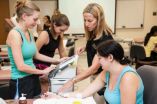(Press-News.org) The Annual Meeting of the American Crystallographic Association (ACA) will be held July 28 – Aug. 1, 2012, at the Westin Waterfront Hotel in Boston, Mass. Crystallography is the science devoted to exploring the arrangement of atoms in regular crystalline solids and in complicated molecules. Scientists will present research spanning a diverse array of disciplines, including medicine, genomics, material science, and structural biology.
The following summaries link to full news releases and highlight a few of the meeting's many noteworthy talks.
Speed and power of X-ray laser helps unlock molecular mysteries: New nanocrystallography technique shines light on biomolecules in action: By outrunning a laser's path of destruction, an international research team has created 3D images of fragile but biologically important molecules inside protein nanocrystals. Using the Linac Coherence Light Source (LCLS), a powerful X-ray laser at the SLAC National Accelerator Laboratory in Menlo Park, Calif., the scientists fired femtosecond (one quadrillionth of a second) bursts of light at a stream of tumbling molecules, obliterating them as they pass, but not before capturing otherwise illusive images of their crystalline structures. Read full news release here: http://www.eurekalert.org/pub_releases/2012-07/aiop-sap072512.php. [Buerger Award presentation and talk AW.01.1, "Fast molecular imaging with an X-ray laser," is in the morning on Sunday, July 29.]
Delving into the molecular mechanism behind deep-sea bacteria's pressure tolerance: The Mariana Trench is the deepest feature of the Earth's surface. The water column there exerts a pressure of more than one thousand times normal atmospheric pressure at sea level, enough pressure to crush an SUV. Yet many organisms thrive in this seemingly inhospitable environment. A Japanese research team has been investigating how deep-sea bacteria adapt to such high-pressure conditions. They have identified a structural change that confers pressure-resistant properties on a particular protein found in bacteria. Read full news release here: http://www.eurekalert.org/pub_releases/2012-07/aiop-dit072512.php. [Poster 01.02.17, "High-pressure-induced water penetration and pressure adaptation of IPMDH from deep-sea bacteria," is in the afternoon session on Sunday, July 29.]
Researchers dig through the gene bank to uncover the roots of the evolutionary tree: Ever since Darwin first published The Origin of the Species, scientists have been striving to identify a last universal common ancestor of all living species. Paleontological, biochemical, and genomic studies have produced conflicting versions of the evolutionary tree. Now a team of researchers, led by a professor at the State University of New York at Buffalo and including area high school students, has developed a novel method to search the vast archives of known gene sequences to identify and compare similar proteins across the many kingdoms of life. Using the comparisons to quantify the evolutionary closeness of different species, the researchers have identified Actinobacteria, a group of single membrane bacteria that include common soil and water life forms, as the base of the evolutionary tree. Read full news release here: http://www.eurekalert.org/pub_releases/2012-07/aiop-rdt072512.php. [Presentation 03.01, "Evolutionary Tree of All Species from X-ray Structure
and Sequence Alignment," is in the afternoon session on Sunday, July 29 and presentation 03.02.08, "Analysis of Ribosomal Protein S13: Sequence Alignment Analysis Suggests Rooted Phylogenetic Tree," is in the afternoon session on Wednesday, Aug. 1.]
Researchers unveil molecular details of how bacteria propagate antibiotic resistance: Fighting "superbugs" – strains of pathogenic bacteria that are impervious to the antibiotics that subdued their predecessor generations – has required physicians to seek new and more powerful drugs for their arsenals. Unfortunately, in time, these treatments also can fall prey to the same microbial ability to become drug resistant. Now a research team at the University of North Carolina at Chapel Hill (UNC) may have found a way to break the cycle that doesn't demand the deployment of a next-generation medical therapy: preventing "superbugs" from genetically propagating drug resistance. Read full news release here: http://www.eurekalert.org/pub_releases/2012-07/aiop-rum072612.php. [The poster 13.22.24, "Development of Novel Antibiotics Through Structural and Biochemical Analysis of the NES Relaxase from the Vancomycin Resistance Plasmid pLW1043," is in the afternoon session on Monday, Aug. 1.]
### This news release was prepared for the American Crystallographic Association (ACA) by the American Institute of Physics (AIP).
MORE INFORMATION ABOUT THE 2012 ACA MEETING
The ACA is the largest professional society for crystallography in the United States, and this is its main meeting. All scientific sessions, workshops, poster sessions, and events will be held at the Westin Waterfront Hotel in Boston, Mass.
USEFUL LINKS:
Main meeting website: http://www.amercrystalassn.org/2012-meeting-homepage
Meeting program: http://www.amercrystalassn.org/2012-tentative-program
Meeting abstracts: http://www.amercrystalassn.org/app/sessions
Exhibits: http://www.amercrystalassn.org/2012-exhibits
ABOUT ACA
The American Crystallographic Association (ACA) was founded in 1949 through a merger of the American Society for X-Ray and Electron Diffraction (ASXRED) and the Crystallographic Society of America (CSA). The objective of the ACA is to promote interactions among scientists who study the structure of matter at atomic (or near atomic) resolution. These interactions will advance experimental and computational aspects of crystallography and diffraction. They will also promote the study of the arrangements of atoms and molecules in matter and the nature of the forces that both control and result from them.
Powerful lasers, deep-sea bacteria's pressure tolerance, and more at meeting of crystallographers
2012-07-27
ELSE PRESS RELEASES FROM THIS DATE:
Standard radiation therapy dose provides pain relief for painful heel spurs
2012-07-27
Patients with plantar fasciitis (painful bone heel spur) experience significantly less pain and improved quality of life following a standard dose of external beam radiation therapy, a common cancer treatment similar to receiving an X-ray, according to a randomized, cooperative group study that was published online July 25, 2012, in the International Journal of Radiation, Oncology, Biology, Physics (Red Journal), the official scientific journal of the American Society for Radiation Oncology (ASTRO).
Approximately 8-10 percent of the population has severe bone heel spurs, ...
Molecule found that inhibits recovery from stroke
2012-07-27
FINDINGS:
Researchers at UCLA have identified a novel molecule in the brain that, after stroke, blocks the formation of new connections between neurons. As a result, it limits the brain's recovery. In a mouse model, the researchers showed that blocking this molecule—called ephrin-A5--induces axonal sprouting, that is, the growth of new connections between the brain's neurons, or cells, and as a result promotes functional recovery.
IMPACT:
If duplicated in humans, the identification of this molecule could pave the way for a more rapid recovery from stroke and may ...
Climate change could open trade opportunities for some vulnerable nations
2012-07-27
Tanzania is one developing country that could actually benefit from climate change by increasing exports of corn to the U.S. and other nations, according to a study by researchers at Stanford University, the World Bank and Purdue University.
The study, published in the Review of Development Economics, shows the African country better known for safaris and Mt. Kilimanjaro has the potential to substantially increase its maize exports and take advantage of higher commodity prices with a variety of trading partners due to predicted dry and hot weather that could affect those ...
Expanded analysis of HPTN 052 study results show cost-effectiveness of early treatment of HIV
2012-07-27
When the HIV Prevention Trials Network (HPTN) 052 investigators released their landmark study results last year showing that treatment can reduce HIV transmission by 96% in serodiscordant couples, questions were raised about the cost of early antiretroviral therapy (ART) and if it should be universally implemented. Data presented today at the XIX International AIDS Conference in Washington, D.C. show that treatment as prevention is "very cost-effective". Using an HIV microsimulation model (CEPAC-International) to further expand analysis of HPTN 052 data, study investigators ...
Computers can predict effects of HIV policies
2012-07-27
PROVIDENCE, R.I. [Brown University] — Policymakers struggling to stop the spread of HIV grapple with "what if" questions on the scale of millions of people and decades of time. They need a way to predict the impact of many potential interventions, alone or in combination. In two papers to be presented at the 2012 International AIDS Society Conference in Washington, D.C., Brandon Marshall, assistant professor of epidemiology at Brown University, will unveil a computer program calibrated to model accurately the spread of HIV in New York City over a decade and to make specific ...
Accelerated resolution therapy significantly reduces PTSD symptoms, researchers report
2012-07-27
July 27, 2012 (Tampa, FL) – Researchers at the University of South Florida (USF) College of Nursing have shown that brief treatments with Accelerated Resolution Therapy (ART) substantially reduce symptoms associated with post-traumatic stress disorder (PTSD) including, depression, anxiety, sleep dysfunction and other physical and psychological symptoms. The findings of this first study of ART appear in an on-line article published June 18, 2012 in the Journal Behavioral Sciences.
ART is being studied as an alternative to traditional PTSD treatments that use drugs or ...
The Olympics and bare feet: What have we learned?
2012-07-27
Ethiopian runner Abebe Bikila made history when he earned a gold medal at the 1960 Summer Olympics in Rome. His speed and agility won him the gold, but it was barefoot running that made him a legend.
When the shoes Bikila was given for the race didn't fit comfortably, he ditched them for his bare feet. After all, that's the way he had trained for the Olympics in his homeland.
Racing shoeless led to success for Bikila, and now, more than 50 years later, runners are continuing to take barefoot strides. Several Olympic runners have followed Bikila and nationally the trend ...
In-utero exposure to magnetic fields associated with increased risk of obesity in childhood
2012-07-27
In-utero exposure to relatively high magnetic field levels was associated with a 69 percent increased risk of being obese or overweight during childhood compared to lower in-utero magnetic field levels, according to a Kaiser Permanente study that appears in the current online version of Nature's Scientific Reports.
Researchers conducted the prospective cohort study, in which participating women in Kaiser Permanente's Northern California region carried a meter measuring magnetic field levels during pregnancy and 733 of their children were followed up to 13 years, to collect ...
Future of California high-speed rail looks green
2012-07-27
Berkeley — A new analysis gives Californians good reason to be optimistic about the green credentials of the state's proposed high-speed rail project, due to begin construction in 2013 thanks to funding recently approved by state legislators.
Arpad Horvath at the University of California, Berkeley, and Mikhail Chester at Arizona State University compared the future sustainability of California high-speed rail with that of competing modes of transportation, namely automobile and air travel. They determined that, in terms of energy consumption and greenhouse gas emissions, ...
Breakthrough treatment reduces post-surgical scarring for glaucoma patients
2012-07-27
Scientists at the Singapore Eye Research Institute (SERI) and Nanyang Technological University (NTU) have developed an innovative way to combat post-surgical scarring for glaucoma patients.
A clinical trial has shown that the use of a new drug delivery method has resulted in 40 per cent fewer injections needed by glaucoma patients to prevent scarring after surgery. This also means fewer hospital visits for these patients in future.
Glaucoma, a disease characterised by a build-up of pressure in the eye, is a major cause of blindness worldwide. It affects about 3 per ...

